#RelationalDatabases
Explore tagged Tumblr posts
Text
Studying Data Analytics (SQL)
At present I’m working through the 2nd Edition of Practical SQL by Anthony DeBarros. I plan to obtain a graduate certificate in Healthcare Data Analytics so I’m teaching myself the basics so to help ease the burden of working and going to school.
Here’s how I study.
First I always dedicate a notebook (or series of them) to a learning goal. I like Leuchtturm notebooks as they are fountain pen friendly and plenty of colors (to distinguish from my other notebooks), and have a built in table of contents for organization.
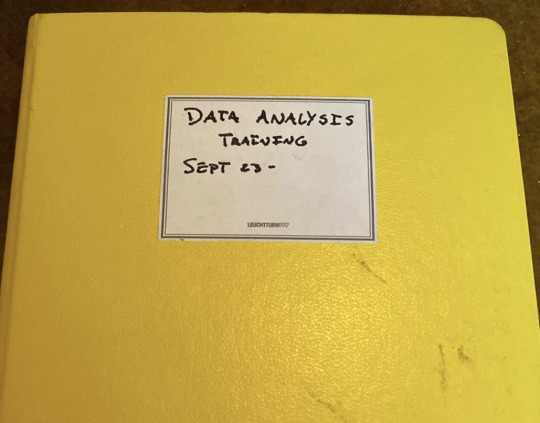
SQL, Python, R, etc are programming languages used to tell their respective software what to do with data that has been input into the database. To oversimplify you are learning to speak computer. So my process in learning is by breaking the text down into scenarios e.g If I want to do X, my code needs to look like Y

Along with code examples I include any caveats or alternate use cases. This is repetition helps me learn the syntax and ingrain it into my memory. Obviously I color code my notes so I can know at a glance what each element of the code is.
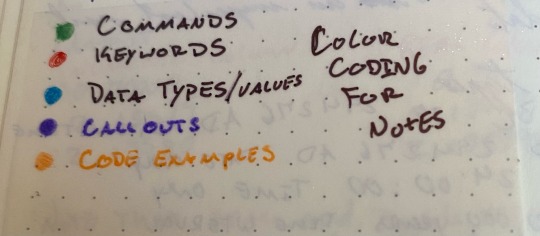
My multi-pen a Hi-tech C Coleto has been invaluable so I don’t have to jump between 5 different pens I just click between them as needed.
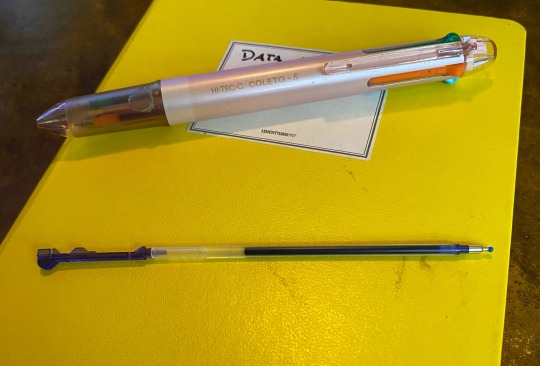
That said as the Coleto will hold 5 different colors it means the refill are tiny and thus need to be replaced more often. Which can be annoying if I run out mid study session.
The end game is to take these notes build a Data Grimoire where I can quickly reference code and how to use them as well as to build checklists for things like data cleaning, setting up constraints, and for thinking ahead to future needs (e.g int vs bigint)
#black dark academia#dark academia#noir library#poc dark academia#studying#studyblr#I’m aware GitHub exists im just dramatic and like to handwrite things#data analytics#datascience#relationaldatabases#multipens#Hi Tec-C Coleto#leuchtturm
2 notes
·
View notes
Text
Relational vs. Non-Relational Databases: Key Differences Explained
Relational databases use structured tables with predefined schemas and support SQL for querying, making them ideal for structured data and complex relationships. Non-relational databases, like NoSQL, offer flexibility with unstructured or semi-structured data, excelling in scalability and performance for big data and real-time applications. Each suits different use cases based on data type and Read More..
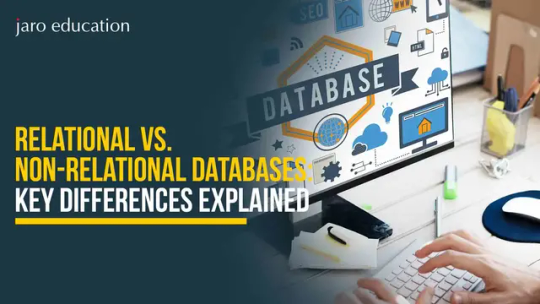
0 notes
Text
4DBInfer: A Tool for Graph-Based Prediction in Databases

4DBInfer
A database-based graph-centric predictive modelling benchmark.
4DBInfer enables model comparison, prediction tasks, database-to-graph extraction, and graph-based predictive architectures.
4DBInfer, an extensive open-source benchmarking toolbox, focusses on graph-centric predictive modelling on Relational Databases (RDBs). Shanghai Lablet of Amazon built it to meet the major gap in well-established, publically accessible RDB standards for training and assessment.
As computer vision and natural language processing advance, predictive machine learning models using RDBs lag behind. The lack of public RDB benchmarks contributes to this gap. Single-table or graph datasets from preprocessed relational data often form the basis for RDB prediction models. RDBs' natural multi-table structure and properties are not fully represented by these methods, which may limit model performance.
4DBInfer addresses this with a 4D exploring framework. The 4-D design of RDB predictive analytics allows for deep exploration of the model design space and meticulous comparison of baseline models along these four critical dimensions:
4DBInfer includes RDB benchmarks from social networks, advertising, and e-commerce. Temporal evolution, schema complexity, and scale (billions of rows) vary among these datasets.
For every dataset, 4DBInfer finds realistic prediction tasks, such as estimating missing cell values.
Techniques for RDB-to-graph extraction: The program supports many approaches to retain the rich tabular information of big RDBs' structured data while transforming it into graph representations. The Row2Node function turns every table row into a graph node with foreign-key edges, whereas the Row2N/E method turns some rows into edges only to capture more sophisticated relational patterns. Additionally, “dummy tables” improve graph connectivity. According to the text, these algorithms subsample well.
FourDBInfer implements several resilient baseline structures for graph-based learning. These cover early and late feature-fusion paradigms. Deep Feature Synthesis (DFS) models collect tabular data from the graph before applying typical machine learning predictors, while Graph Neural Networks (GNNs) train node embeddings using relational message passing. These trainable models output subgraph-based predictions with well-matched inductive biases.
Comprehensive 4DBInfer tests yielded many noteworthy findings:
Graph-based models that use the complete multi-table RDB structure usually perform better than single-table or table joining models. This shows the value of RDB relational data.
The RDB-to-graph extraction strategy considerably affects model performance, emphasising the importance of design space experimentation.
GNNs and other early feature fusion graph models perform better than late-fusion models. Late-fusion models can compete, especially with computing limits.
Model performance depends on the job and dataset, underscoring the need for many benchmarks to provide correct findings.
The results suggest a future research topic: the tabular-graph machine learning paradigm nexus may yield the best solutions.
4DBInfer provides a consistent, open-sourced framework for the community to develop creative approaches that accelerate relational data prediction research. The source code of 4DBInfer is public.
#4DBInfer#RelationalDatabases#RDBbenchmarks#machinelearning#GraphNeuralNetworks#predictivemachinelearning#technology#technews#technologynews#news#govindhtech
0 notes
Text
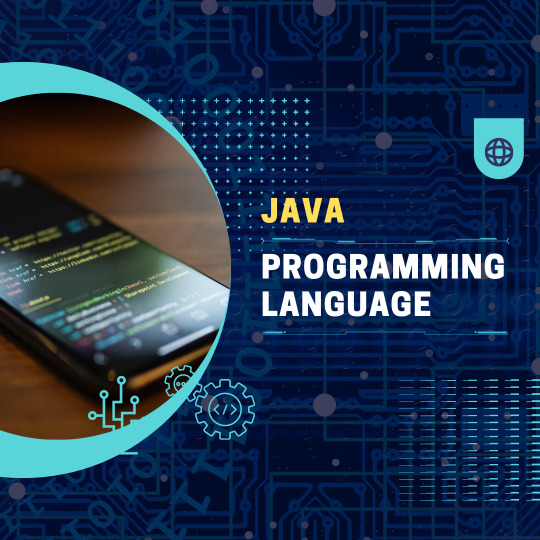
#DataEngineers#DataEngineering#Infrastructure#DataSystems#DataAvailability#DataAccessibility#ProgrammingLanguages#Python#Java#Scala#DataPipelines#DataWorkflows#Databases#SQL#NoSQL#RelationalDatabases#DistributedDataStores#DataWarehousing#AmazonRedshift#GoogleBigQuery#Snowflake#BigDataTechnologies#Hadoop#Spark#ETLTools#ApacheNiFi#Talend#Informatica#DataModelingTools#DataIntegrationTools
0 notes
Text
MySQL database courses Coding Bit
MySQL database courses is an open-source relational database management system (RDBMS) based on Structured Query Language (SQL). It is used to store, manage, and retrieve data for websites and applications. MySQL is known for its speed, reliability, and ease of use, and is widely used with web technologies, especially PHP.
Key Features:
Relational database: Organizes data in tables with rows and columns.
SQL support: Uses SQL for querying and managing data.
Open-source: Free to use under the GNU General Public License (GPL).
Cross-platform: Runs on Windows, Linux, macOS, etc.
Scalable: Suitable for both small and large applications.
Secure: Supports user access control and encryption.
Common Uses:
Websites (e.g., with WordPress, Joomla)
Web apps (e.g., e-commerce, blogs)
Data warehousing
Logging systems 📞 Phone Number: +91 9511803947 📧 Email Address: [email protected]
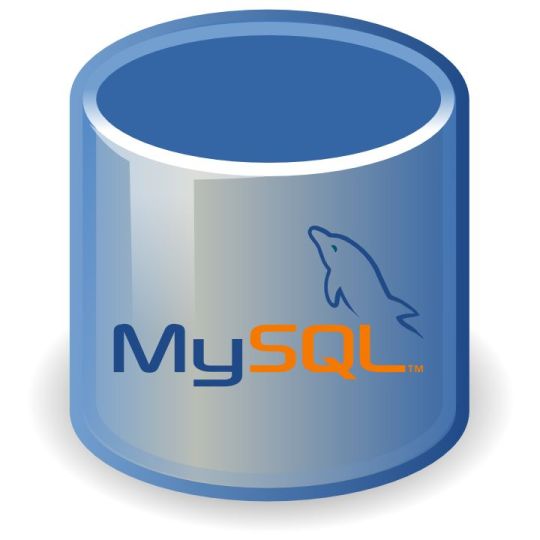
#MySQL#Database#SQL#RelationalDatabase#MySQLDatabase#SQLQuery#OpenSourceDatabase#DataManagement#MySQLTips
0 notes
Text
MySQL is an open-source relational database management system (RDBMS) that is widely used for storing, managing, and retrieving data efficiently. It is one of the most popular database systems, known for its speed, reliability, and ease of use. MySQL is commonly used in web development, powering applications such as WordPress, Facebook, and many others.
#MySQL#Database#SQL#DatabaseManagement#TechEducation#MySQLTutorial#SQLDatabase#TechBooks#DataManagement#MySQLForBeginners#TechLearning#RelationalDatabase#DatabaseDesign#MySQLQueries#CRUDOperations#DatabaseOptimization#MySQLDatabase#WebDevelopment#TechTutorial#BackendDevelopment#MySQLAdmin#DatabaseSecurity#DataModeling#MySQLTips#WebAppDevelopment#MySQLBestPractices
0 notes
Text
What is a Database Management System (DBMS)? Explained with types, functions, and benefits. Learn DBMS concepts at TCCI-Tririd Computer Coaching Institute.
#DBMS#DatabaseManagement#WhatIsDBMS#DBMSExplained#DataStorage#SQL#RelationalDatabase#DataSecurity#TCCI#ComputerEducation
0 notes
Text
🌐 What is a Database? A Beginner's Guide 📚
📚💾 What is a Database?
Think of it as a high-tech treasure chest 🪙, storing all your important data in one neat place! From managing your Netflix watchlist 🎬 to saving your online shopping carts 🛍️, databases are the silent heroes 🦸♀️ behind your favorite apps. They keep things organized, searchable 🔍, and ready whenever you need them! 🚀✨

🔍 Types of Databases 🌐
1️⃣ 🗃️ Relational Database: Think of it as a spreadsheet 📊 that organizes data into neat tables. Example: MySQL, PostgreSQL.
2️⃣ 📚 NoSQL Database: For all the messy data 🌀—it handles unstructured info like a pro! Example: MongoDB, Cassandra.
3️⃣ ☁️ Cloud Database: Data stored up in the cloud ☁️, ready to be accessed anytime, anywhere! Example: AWS, Google Cloud.
4️⃣ 🧠 In-Memory Database: Super-fast, like the brain 🧠! Stores data in RAM for lightning-speed access. Example: Redis, Memcached.
5️⃣ 🏙️ Graph Database: Connects the dots 🧩 between data, like a social network! Example: Neo4j, Amazon Neptune.
Why Are Databases Important?
💡 Efficient Data Storage: Organize and store massive amounts of data easily.
🔍 Quick Access: Retrieve information in seconds, making tasks faster.
📈 Data Analysis: Helps businesses make smart decisions with organized data.
🛡️ Data Security: Protects sensitive information with backups and encryption.
🔄 Automation: Automates processes like transactions, inventory updates, and more!
🌍 Scalability: Can grow with your business or website as data increases.
3️⃣ Cool Database Facts
🧠 First Database Ever: IBM’s IMS (Information Management System) was created in the 1960s!
🌍 SQL Dominance: SQL is the most widely used database language around the globe.
🚀 Big Data Power: Databases handle massive amounts of data—Google processes over 40,000 searches per second!
#Database#TechTips#SQL#NoSQL#LearnTech#ProgrammingBasics#DataManagement#DBMS#BigData#DatabaseDesign#DataScience#DataAnalytics#CloudDatabase#DataMining#DatabaseAdministrator#RelationalDatabase#DatabaseOptimization#DataVisualization#DataStorage#DataSecurity#DatabaseDeveloper#DataWarehouse#MachineLearning#BusinessIntelligence
0 notes
Text
MySQL Naming Conventions
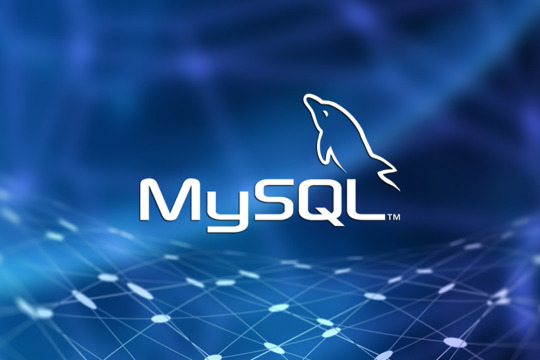
What is MySQL?
MySQL is a freely available open source Relational Database Management System (RDBMS) that uses Structured Query Language (SQL). SQL is the most popular language for adding, accessing and managing content in a database. It is most noted for its quick processing, proven reliability, ease and flexibility of use.
What is a naming convention?
In computer programming, a naming convention is a set of rules for choosing the character sequence to be used for identifiers that denote variables, types, functions, and other entities in source code and documentation.
General rules — Naming conventions
Using lowercase will help speed typing, avoid mistakes as MYSQL is case sensitive.
Space replaced with Underscore — Using space between words is not advised.
Numbers are not for names — While naming, it is essential that it contains only Alpha English alphabets.
Valid Names — Names should be descriptive of the elements. i.e. — Self-explanatory and not more than 64 characters.
No prefixes allowed.
Database name convention
Name can be singular or plural but as the database represents a single database it should be singular.
Avoid prefix if possible.
MySQL table name
Lowercase table name
MySQL is usually hosted in a Linux server which is case-sensitive hence to stay on the safe side use lowercase. Many PHP or similar programming frameworks, auto-detect or auto-generate class-based table names and most of them expect lowercase names.
Table name in singular
The table is made up of fields and rows filled with various forms of data, similarly the table name could be plural but the table itself is a single entity hence it is odd and confusing. Hence use names like User, Comment.
Prefixed table name
The table usually has the database or project name. sometimes some tables may exist under the same name in the database to avoid replacing this, you can use prefixes. Essentially, names should be meaningful and self-explanatory. If you can’t avoid prefix you can fix it using php class.
Field names
Use all above cases which include lowercase, no space, no numbers, and avoid prefix.
Choose short names no-longer than two words.
Field names should be easy and understandable
Primary key can be id or table name_id or it can be a self-explanatory name.
Avoid using reserve words as field name. i.e. — Pre-defined words or Keywords. You can add prefix to these names to make it understandable like user_name, signup_date.
Avoid using column with same name as table name. This can cause confusion while writing query.
Avoid abbreviated, concatenated, or acronym-based names.
Do define a foreign key on database schema.
Foreign key column must have a table name with their primary key.
e.g. blog_id represents foreign key id from table blog.
Avoid semantically — meaningful primary key names. A classic design mistake is creating a table with primary key that has actual meaning like ‘name’ as primary key. In this case if someone changes their name then the relationship with the other tables will be affected and the name can be repetitive losing its uniqueness.
Conclusion
Make your table and database names simple yet understandable by both database designers and programmers. It should things that might cause confusion, issues with linking tables to one another. And finally, it should be readable for programming language or the framework that is implemented.
#MySQL#DatabaseManagement#SQL#NamingConventions#RelationalDatabase#DatabaseDesign#CodingStandards#TableNaming#FieldNaming#DatabaseSchema#ProgrammingTips#DataManagement#CaseSensitivity#PrimaryKey#ForeignKey#DatabaseBestPractices#OpenSource#DatabaseOptimization#MySQLTips#DataStructure
0 notes
Text
Odoo Relational Fields are crucial for robust applications. Discover how many-to-one, one-to-many, and many-to-many relationships function within Odoo's ORM to build superior, well-structured apps. Learn more! #Odoo #OdooORM #RelationalDatabase #OdooDevelopment #Programming
0 notes
Text

📚 Struggling with ICT702 - Introduction to the Relational Database? We've Got You Covered! 💻
Feeling stuck on ER diagrams, SQL queries, or normalization concepts? Don’t worry — get expert help with your ICT702 assignments and boost your confidence (and your grades)! 🧠✅
🔍 We can help you with:
• Entity Relationship (ER) Modeling
• Relational Schema Design
• SQL Query Writing (SELECT, JOIN, GROUP BY, etc.)
• Data Integrity & Constraints
• Normalization (1NF, 2NF, 3NF)
• Database Design Best Practices
👨🏫 Expert tutors | On-time delivery | 100% plagiarism-free work
📩 Message us now for quick, reliable, and affordable assignment assistance!
#ICT702 #RelationalDatabase #DatabaseAssignmentHelp #SQLHelp #UniversityLife #AssignmentSupport #StudentHelp #KingsOwnInstitute #KOI #Australia
0 notes
Text
PostgreSQL : Essential Guide to Getting Started with this Game-Changing Database"
PostgreSQL : Essential Guide to Getting Started with this Game-Changing Database" PostgreSQL is a powerful, open-source object-relational database system that uses and extends the SQL language combined with many features. #postgresql #postgresqldatabase #relationaldatabase #postgresqltutorial #postgresqldevelopment #php #phptutorial #phptutorialpoints #webdevelopment #webdevelopmenttutorial
Practical and dependable data management has never been more important in today’s data-driven world. PostgreSQL, which is also known as “Postgres,” is a premier open-source relational database management system (RDBMS) that has grown in popularity among developers, businesses, and the open-source community. We will look at PostgreSQL’s primary features, benefits, and use cases, as well as why it…

View On WordPress
0 notes
Text

Types of Databases . . . . for more information http://bit.ly/3Zf0cxI check the above link
#data#database#dbms#rdbms#typesofdbms#computer#computerscienece#Centralized#DistributedDatabase#RelationalDatabase#NoSQLDatabase#CloudDatabase#ObjectOrientedDatabases#HierarchicalDatabases#NetworkDatabases#PersonalDatabase#OperationalDatabase#EnterpriseDatabase#javatpoint
0 notes
Text
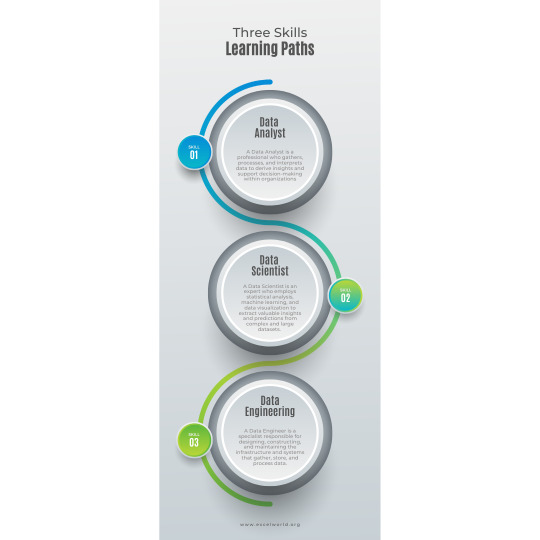
#DataEngineers#DataEngineering#Infrastructure#DataSystems#DataAvailability#DataAccessibility#ProgrammingLanguages#Python#Java#Scala#DataPipelines#DataWorkflows#Databases#SQL#NoSQL#RelationalDatabases#DistributedDataStores#DataWarehousing#AmazonRedshift#GoogleBigQuery#Snowflake#BigDataTechnologies#Hadoop#Spark#ETLTools#ApacheNiFi#Talend#Informatica#DataModelingTools#DataIntegrationTools
0 notes
Video
youtube
AWS EC2 VM Setup | Run Springboot Microservice and Postgres DB in EC2 Se...
Hello friends, a new #video on #aws #cloud #ec2 #server setup #springboot #microservice setup in #ec2server #postgres setup in #ec2instance is published on #codeonedigest #youtube channel. Learn #awsec2 #postgressetup #java #programming #coding with codeonedigest.
@java #java #awscloud @awscloud @AWSCloudIndia #Cloud #CloudComputing @YouTube #youtube #springbootmicroservices #springbootmicroservicesproject #springbootmicroservicestutorial #springbootmicroservicesfullcourse #springbootmicroservicesexample #springbootmicroservicesarchitecture #aws #awscloud #cloud #createawsec2server #createawsec2instance #createawsec2 #awsmanagementconsole #createec2instanceinaws #createec2 #createec2instanceandconnect #createec2instanceinawslinux #awsec2 #awsec2instance #awsec2interviewquestionsandanswers #awsec2instancecreation #awsec2deploymenttutorial #installpostgresec2install #installpostgresec2linux #awsec2connect #awsec2statuschecks #awsec2project #awsec2full #awsec2createinstance #awsec2interviewquestionsandanswersforfreshers #awsec2instancedeployment #awsec2 #awsec2serialconsole #awsec2consolewindows #awsec2serverrefusedourkey #awsec2serialconsolepassword #awsec2serviceinterviewquestions #awsec2serialconsoleaccess #awsec2serialrefusedourkeyputty #awsec2serverconfiguration #awsec2serialconnect #awsec2 #awsec2instance #awsec2instancecreation #awsec2instanceconnect #awsec2instancedeployment #awsec2instancelinux #awsec2instancelaunch #awsec2instanceconnectnotworking #awsec2instanceinterviewquestions #awsec2instancecreationubuntu #awstutorial #awsec2tutorial #ec2tutorial #postgresandpgadmininstall #postgresandpgadmininstallwindows #postgresandpgadmininstallubuntu #postgresandpgadmininstallwindows11 #postgresandpgadmininstallmacos #postgresandpgadmininstallwindows10 #postgrespasswordreset #postgrestutorial #postgresdocker #postgresinstallationerror #postgres #postgresdatabase #rdbms #postgresdatabasesetup #postgresdatabaseconfiguration #database #relationaldatabase #postgresconfiguration #postgresconfigurationfile #postgresconfigurationparameters #postgresconfigfilelocation #postgresconfigurationinspringboot #postgresconfigfilewindows #postgresconfigfilemax #postgresconfigfileubuntu #postgresconfigurereplication #postgresconfigurationsettings #postgresconnectiontoserver #postgresconnectioninjava #postgresconnectioncommandline #postgresconnectioninnodejs#postgrestutorial #postgresdocker #postgresinstallationerror #postgres #postgresdatabase #rdbms #postgresdatabasesetup #postgresdatabaseconfiguration #database #relationaldatabase #postgresconfiguration #postgresconfigurationfile #postgresconfigurationparameters #postgresconfigfilelocation #postgresconfigurationinspringboot #postgresconfigfilewindows #postgresconfigfilemax #postgresconfigfileubuntu #postgresconfigurereplication #postgresconfigurationsettings #postgresconnectiontoserver #postgresconnectioninjava #postgresconnectioncommandline #postgresconnectioninnodejs
Hello Friend, Thanks for following us here.
#youtube#aws#ec2#aws ec2#aws cloud#cloud#s3 bucket#aws s3 bucket#postgres db#postgresdb#postgres#rdbms#spring#springboot#microservice#springboot microservice#spring boot#microservices
2 notes
·
View notes
Photo

Introduction to Databases and How We Store Information in Computers
This article is just a small introduction to databases that hopefully will help you in getting familiar with the topic. It is deliberately simple and intends to provide an overview of the domain. A database is an organized collection of data, generally stored and accessed electronically from
Check out the full version of the post at: https://francescolelli.info/tutorial/introduction-to-databases-and-how-we-store-information-in-computers/ You will find more information about that as part as a collection of articles about Information Management, Computer Science, Economics, Finance and More.
Title: Introduction to Databases and How We Store Information in Computers
This article can be categorized as follow: Programming, Tutorial
Relevant keywords includes: Databases, Flat Databases, Introduction, non-relational databases, relational databases, SQL, SQL Databases
Tags as hashtags #Databases, #FlatDatabases, #Introduction, #NonRelationalDatabases, #RelationalDatabases, #SQL, #SQLDatabases
categories as hashtags #Programming, #Tutorial
Published by Francesco Lelli at Francesco Lelli a blog about Information Management, Computer Science, Finance, Economics and more
Announce: This article is just a small introduction to databases that hopefully will help you in getting familiar with the topic. It is deliberately simple and intends to provide an overview of the domain. A database is an organized collection of data, generally stored and accessed electronically from
RawExcerpt: This article is just a small introduction to databases that hopefully will help you in getting familiar with the topic. It is deliberately simple and intends to provide an overview of the domain. A database is an organized collection of data, generally stored and accessed electronically from a computer system. The databases that are more…
Excerpt: This article is just a small introduction to databases that hopefully will help you in getting familiar with the topic. It is deliberately simple and intends to provide an overview of the domain. A database is an organized collection of data, generally stored and accessed electronically from a computer system. The databases that are more…
#Databases#Flat Databases#Introduction#non-relational databases#relational databases#SQL#SQL Databases
379 notes
·
View notes